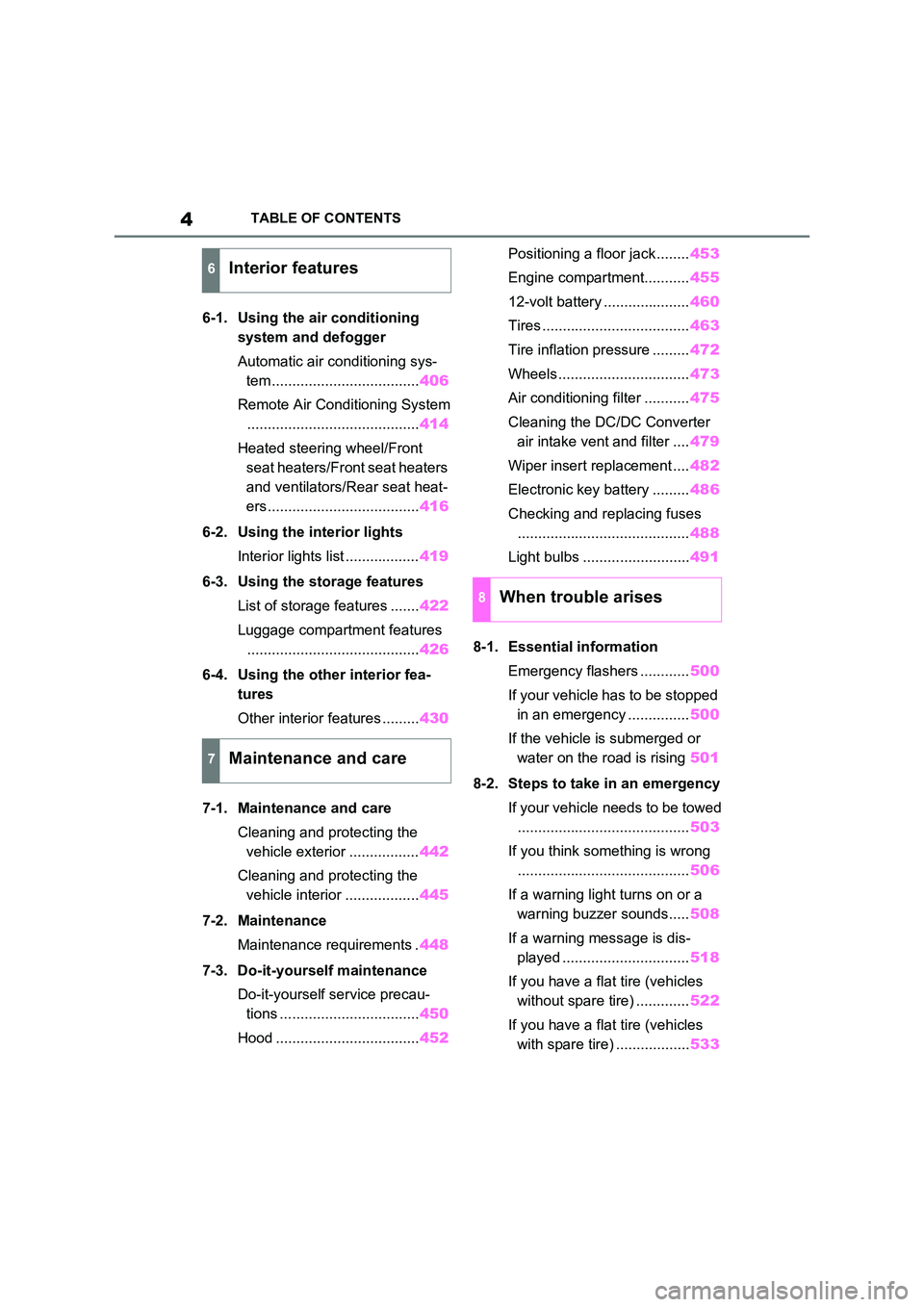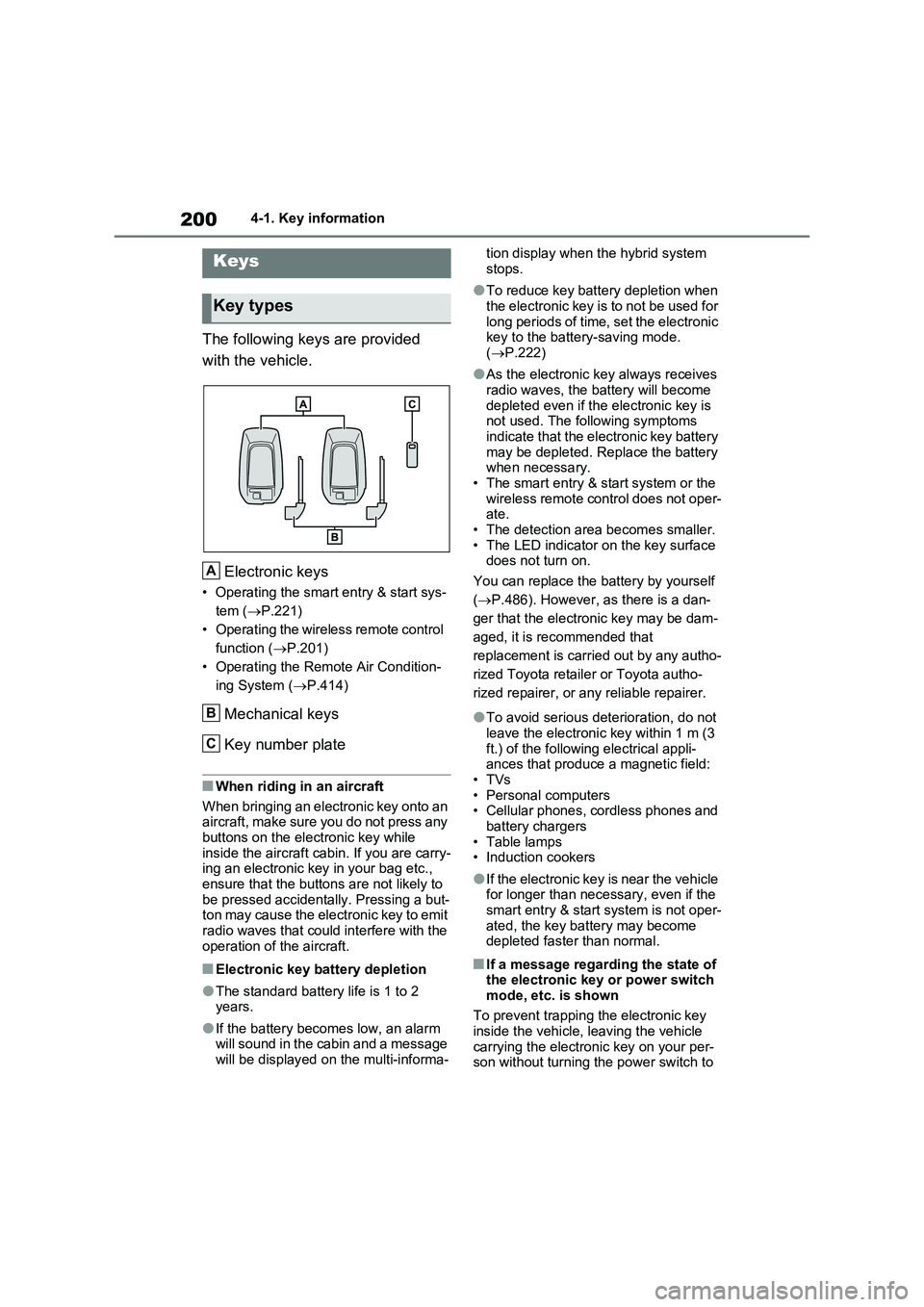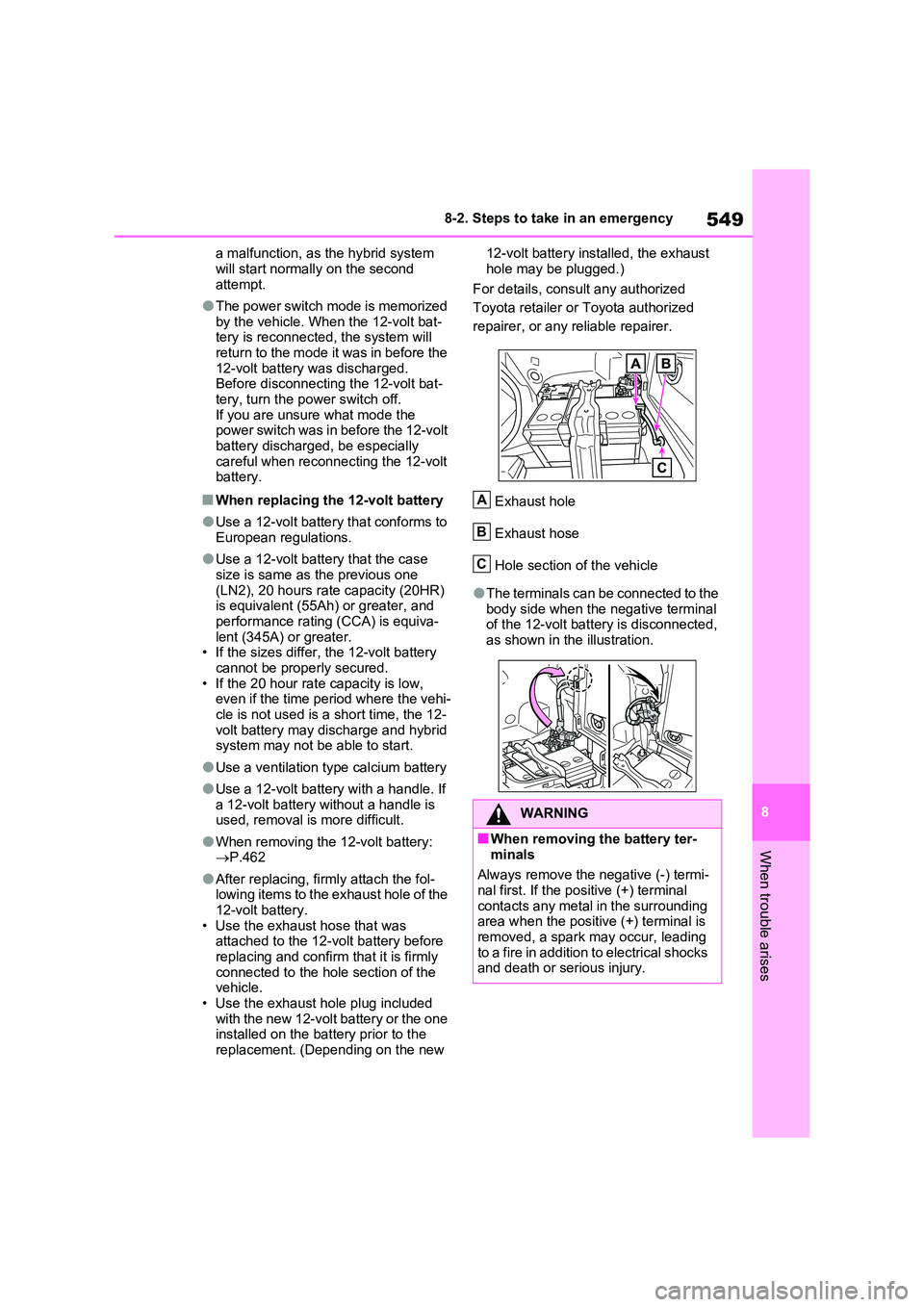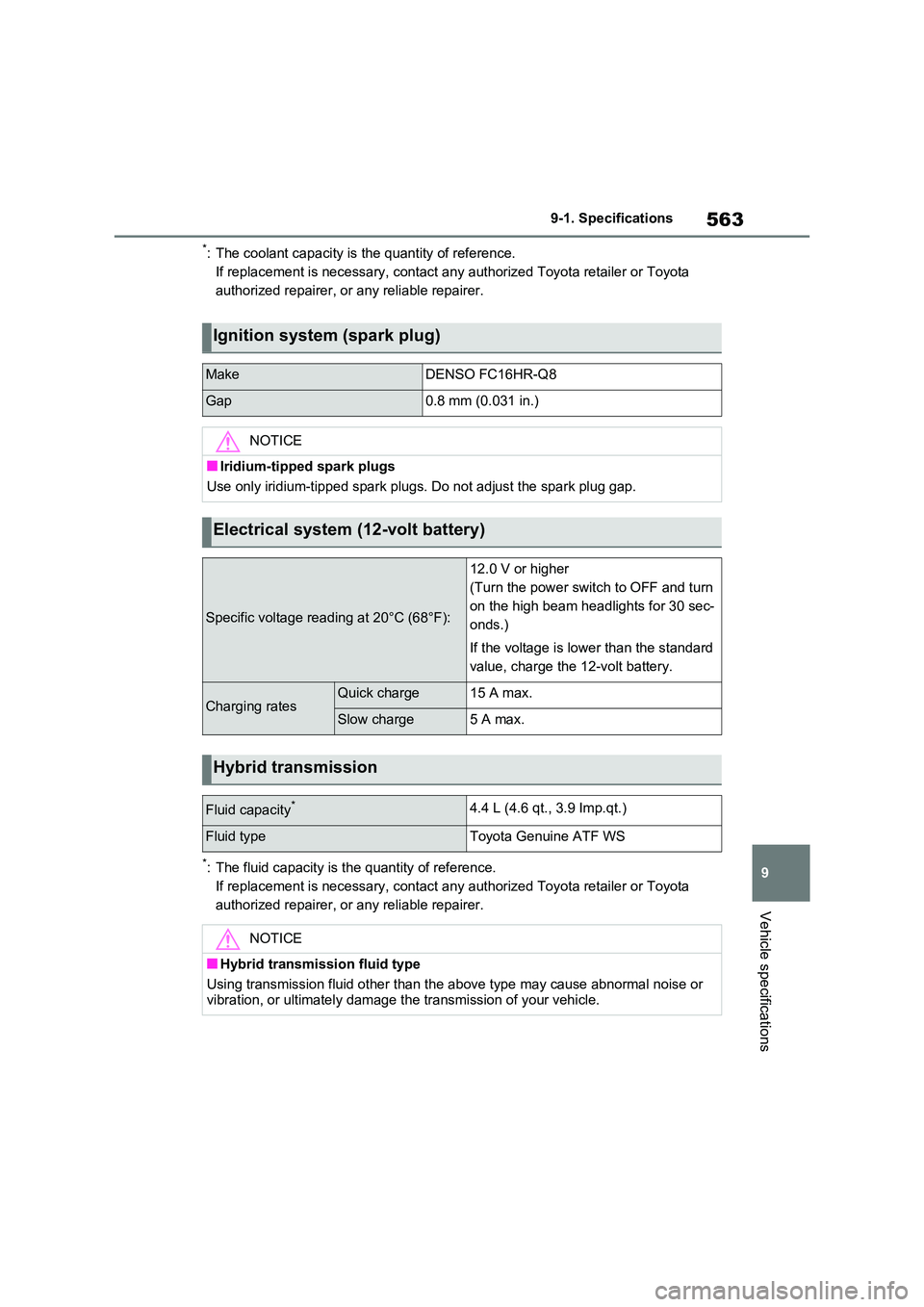battery replacement TOYOTA RAV4 PLUG-IN HYBRID 2022 Owners Manual
[x] Cancel search | Manufacturer: TOYOTA, Model Year: 2022, Model line: RAV4 PLUG-IN HYBRID, Model: TOYOTA RAV4 PLUG-IN HYBRID 2022Pages: 662, PDF Size: 163.06 MB
Page 6 of 662

4TABLE OF CONTENTS
6-1. Using the air conditioning
system and defogger
Automatic air conditioning sys-
tem .................................... 406
Remote Air Conditioning System
.......................................... 414
Heated steering wheel/Front
seat heaters/Front seat heaters
and ventilators/Rear seat heat-
ers..................................... 416
6-2. Using the interior lights
Interior lights list .................. 419
6-3. Using the storage features
List of storage features ....... 422
Luggage compartment features
.......................................... 426
6-4. Using the other interior fea-
tures
Other interior features ......... 430
7-1. Maintenance and care
Cleaning and protecting the
vehicle exterior ................. 442
Cleaning and protecting the
vehicle interior .................. 445
7-2. Maintenance
Maintenance requirements . 448
7-3. Do-it-yourself maintenance
Do-it-yourself service precau-
tions .................................. 450
Hood ................................... 452
Positioning a floor jack ........ 453
Engine compartment........... 455
12-volt battery ..................... 460
Tires .................................... 463
Tire inflation pressure ......... 472
Wheels ................................ 473
Air conditioning filter ........... 475
Cleaning the DC/DC Converter
air intake vent and filter .... 479
Wiper insert replacement .... 482
Electronic key battery ......... 486
Checking and replacing fuses
.......................................... 488
Light bulbs .......................... 491
8-1. Essential information
Emergency flashers ............ 500
If your vehicle has to be stopped
in an emergency ............... 500
If the vehicle is submerged or
water on the road is rising 501
8-2. Steps to take in an emergency
If your vehicle needs to be towed
.......................................... 503
If you think something is wrong
.......................................... 506
If a warning light turns on or a
warning buzzer sounds..... 508
If a warning message is dis-
played ............................... 518
If you have a flat tire (vehicles
without spare tire) ............. 522
If you have a flat tire (vehicles
with spare tire) .................. 533
6Interior features
7Maintenance and care
8When trouble arises
Page 202 of 662

2004-1. Key information
4-1.Key info rmation
The following keys are provided
with the vehicle.
Electronic keys
• Operating the smart entry & start sys-
tem ( P.221)
• Operating the wireless remote control
function ( P.201)
• Operating the Remote Air Condition-
ing System ( P.414)
Mechanical keys
Key number plate
�QWhen riding in an aircraft
When bringing an electronic key onto an aircraft, make sure you do not press any
buttons on the electronic key while inside the aircraft cabin. If you are carry-ing an electronic key in your bag etc.,
ensure that the buttons are not likely to be pressed accidentally. Pressing a but-ton may cause the electronic key to emit
radio waves that could interfere with the operation of the aircraft.
�QElectronic key battery depletion
�OThe standard battery life is 1 to 2 years.
�OIf the battery becomes low, an alarm will sound in the cabin and a message will be displayed on the multi-informa-
tion display when the hybrid system
stops.
�OTo reduce key battery depletion when
the electronic key is to not be used for long periods of time, set the electronic key to the battery-saving mode.
( P.222)
�OAs the electronic key always receives
radio waves, the battery will become depleted even if the electronic key is not used. The following symptoms
indicate that the electronic key battery may be depleted. Replace the battery when necessary.
• The smart entry & start system or the wireless remote control does not oper-ate.
• The detection area becomes smaller. • The LED indicator on the key surface does not turn on.
You can replace the battery by yourself
( P.486). However, as there is a dan-
ger that the electronic key may be dam-
aged, it is recommended that
replacement is carried out by any autho-
rized Toyota retailer or Toyota autho-
rized repairer, or any reliable repairer.
�OTo avoid serious deterioration, do not leave the electronic key within 1 m (3
ft.) of the following electrical appli- ances that produce a magnetic field:•TVs
• Personal computers • Cellular phones, cordless phones and battery chargers
•Table lamps • Induction cookers
�OIf the electronic key is near the vehicle for longer than necessary, even if the smart entry & start system is not oper-
ated, the key battery may become depleted faster than normal.
�QIf a message regarding the state of the electronic key or power switch
mode, etc. is shown
To prevent trapping the electronic key inside the vehicle, leaving the vehicle
carrying the electronic key on your per- son without turning the power switch to
Keys
Key types
A
B
C
Page 400 of 662

3985-6. Driving tips
5-6.Driving tips
Use fluids that are appropriate to
the prevailing outside tempera-
tures.
• Engine oil
• Engine coolant
• Power control unit coolant
• Washer fluid
Have a service technician
inspect the condition of the 12-
volt battery.
Have the vehicle fitted with four
snow tires or purchase a set of
tire chains for the front tires.
Ensure that all tires are the same size
and brand, and that chains match the
size of the tires.*
*: Tire chains cannot be mounted on
vehicles with 235/55R19 tires.
Winter driving tips
Carry out the necessary prepa-
rations and inspections before
driving the vehicle in winter.
Always drive the vehicle in a
manner appropriate to the pre-
vailing weather conditions.
Pre-winter preparations
WARNING
�QDriving with snow tires
Observe the following precautions to reduce the risk of accidents.
Failure to do so may result in a loss of vehicle control and cause death or serious injury.
�OUse tires of the specified size.
�OMaintain the recommended level of air pressure.
�ODo not drive at speeds in excess of the speed limit or the speed limit specified for the snow tires being
used.
�OUse snow tires on all, not just some
wheels.
�QDriving with tire chains (except
235/55R19 tires)
Observe the following precautions to reduce the risk of accidents.
Failure to do so may result in the vehi- cle being unable to be driven safely, and may cause death or serious
injury.
�ODo not drive in excess of the speed
limit specified for the tire chains being used, or 50 km/h (30 mph), whichever is lower.
�OAvoid driving on bumpy road sur-faces or over potholes.
�OAvoid sudden acceleration, abrupt steering, sudden braking and shift-
ing operations that cause sudden engine braking.
�OSlow down sufficiently before enter-ing a curve to ensure that vehicle control is maintained.
�ODo not use LTA (Lane Tracing Assist) system (if equipped).
NOTICE
�QRepairing or replacing snow tires
Request repairs or replacement of snow tires from any authorized
Toyota retailer or Toyota authorized repairer, or any reliable repairer or legitimate tire retailers.
This is because the removal and attachment of snow tires affects the operation of the tire pressure warning
valves and transmitters.
Page 443 of 662

7
441
7
Maintenance and care
Maintenance and care
7-1. Maintenance and care
Cleaning and protecting the
vehicle exterior ............... 442
Cleaning and protecting the
vehicle interior ................ 445
7-2. Maintenance
Maintenance requirements 448
7-3. Do-it-yourself maintenance
Do-it-yourself service precau-
tions ................................ 450
Hood ................................. 452
Positioning a floor jack...... 453
Engine compartment ........ 455
12-volt battery ................... 460
Tires.................................. 463
Tire inflation pressure ....... 472
Wheels.............................. 473
Air conditioning filter ......... 475
Cleaning the DC/DC Con-
verter air intake vent and filter
....................................... 479
Wiper insert replacement .. 482
Electronic key battery ....... 486
Checking and replacing fuses
....................................... 488
Light bulbs ........................ 491
Page 551 of 662

549
8
8-2. Steps to take in an emergency
When trouble arises
a malfunction, as the hybrid system
will start normally on the second attempt.
�OThe power switch mode is memorized by the vehicle. When the 12-volt bat-tery is reconnected, the system will
return to the mode it was in before the 12-volt battery was discharged. Before disconnecting the 12-volt bat-
tery, turn the power switch off. If you are unsure what mode the power switch was in before the 12-volt
battery discharged, be especially careful when reconnecting the 12-volt battery.
�QWhen replacing the 12-volt battery
�OUse a 12-volt battery that conforms to European regulations.
�OUse a 12-volt battery that the case size is same as the previous one
(LN2), 20 hours rate capacity (20HR) is equivalent (55Ah) or greater, and performance rating (CCA) is equiva-
lent (345A) or greater. • If the sizes differ, the 12-volt battery cannot be properly secured.
• If the 20 hour rate capacity is low, even if the time period where the vehi-cle is not used is a short time, the 12-
volt battery may discharge and hybrid system may not be able to start.
�OUse a ventilation type calcium battery
�OUse a 12-volt battery with a handle. If
a 12-volt battery without a handle is used, removal is more difficult.
�OWhen removing the 12-volt battery: P.462
�OAfter replacing, firmly attach the fol- lowing items to the exhaust hole of the 12-volt battery.
• Use the exhaust hose that was attached to the 12-volt battery before replacing and confirm that it is firmly
connected to the hole section of the vehicle.• Use the exhaust hole plug included
with the new 12-volt battery or the one installed on the battery prior to the replacement. (Depending on the new
12-volt battery installed, the exhaust
hole may be plugged.)
For details, consult any authorized
Toyota retailer or Toyota authorized
repairer, or any reliable repairer.
Exhaust hole
Exhaust hose
Hole section of the vehicle
�OThe terminals can be connected to the body side when the negative terminal of the 12-volt battery is disconnected,
as shown in the illustration.
WARNING
�QWhen removing the battery ter-
minals
Always remove the negative (-) termi- nal first. If the positive (+) terminal
contacts any metal in the surrounding area when the positive (+) terminal is removed, a spark may occur, leading
to a fire in addition to electrical shocks and death or serious injury.
A
B
C
Page 552 of 662

5508-2. Steps to take in an emergency
WARNING
�QAvoiding 12-volt battery fires or explosions
Observe the following precautions to prevent accidentally igniting the flam-mable gas that may be emitted from
the 12-volt battery:
�OMake sure each jumper cable is connected to the correct terminal
and that it is not unintentionally in contact with any other than the intended terminal.
�ODo not allow the other end of the jumper cable connected to the “+”
terminal to come into contact with any other parts or metal surfaces in the area, such as brackets or
unpainted metal.
�ODo not allow the + and - clamps of
the jumper cables to come into con- tact with each other.
�ODo not smoke, use matches, ciga-rette lighters or allow open flame near the 12-volt battery.
�Q12-volt battery precautions
The 12-volt battery contains poison-
ous and corrosive acidic electrolyte, while related parts contain lead and lead compounds. Observe the follow-
ing precautions when handling the 12-volt battery:
�OWhen working with the 12-volt bat-
tery, always wear safety glasses and take care not to allow any bat-tery fluids (acid) to come into con-
tact with skin, clothing or the vehicle body.
�ODo not lean over the 12-volt battery.
�OIn the event that battery fluid comes
into contact with the skin or eyes, immediately wash the affected area with water and seek medical atten-
tion. Place a wet sponge or cloth over the affected area until medical
attention can be received.
�OAlways wash your hands after han- dling the 12-volt battery support, terminals, and other battery-related
parts.
�ODo not allow children near the 12-
volt battery.
�QAfter recharging the 12-volt bat-
tery
Have the 12-volt battery inspected at any authorized Toyota retailer or
Toyota authorized repairer, or any reliable repairer as soon as possible.If the 12-volt battery is deteriorating,
continued use may cause the 12-volt battery to emit a malodorous gas, which may be detrimental to the
health of passengers.
�QWhen replacing the 12-volt bat-
tery
�OFor information regarding 12-volt battery replacement, contact any
authorized Toyota retailer or Toyota authorized repairer, or any reliable repairer.
�OAfter replacing, securely attach the exhaust hose and exhaust hole
plug to the exhaust hole of the replaced 12-volt battery. If not prop-erly installed, gases (hydrogen)
may leak into the vehicle interior, and there is the possible danger of the gas igniting and exploding.
Page 565 of 662

563
9
9-1. Specifications
Vehicle specifications
*: The coolant capacity is the quantity of reference.
If replacement is necessary, contact any authorized Toyota retailer or Toyota
authorized repairer, or any reliable repairer.
*: The fluid capacity is the quantity of reference.
If replacement is necessary, contact any authorized Toyota retailer or Toyota
authorized repairer, or any reliable repairer.
Ignition system (spark plug)
MakeDENSO FC16HR-Q8
Gap0.8 mm (0.031 in.)
NOTICE
�QIridium-tipped spark plugs
Use only iridium-tipped spark plugs. Do not adjust the spark plug gap.
Electrical system (12-volt battery)
Specific voltage reading at 20°C (68°F):
12.0 V or higher
(Turn the power switch to OFF and turn
on the high beam headlights for 30 sec-
onds.)
If the voltage is lower than the standard
value, charge the 12-volt battery.
Charging ratesQuick charge15 A max.
Slow charge5 A max.
Hybrid transmission
Fluid capacity*4.4 L (4.6 qt., 3.9 Imp.qt.)
Fluid typeToyota Genuine ATF WS
NOTICE
�QHybrid transmission fluid type
Using transmission fluid other than the above type may cause abnormal noise or
vibration, or ultimately damage the transmission of your vehicle.